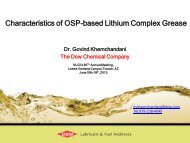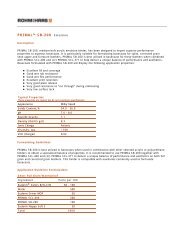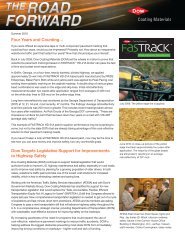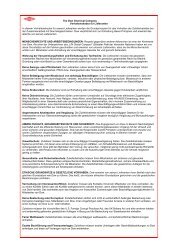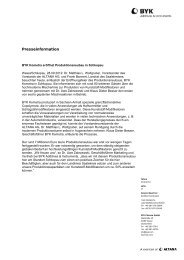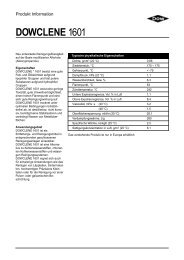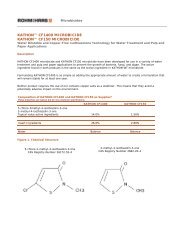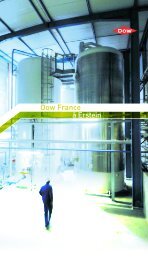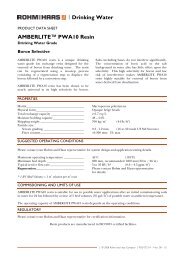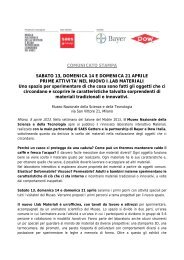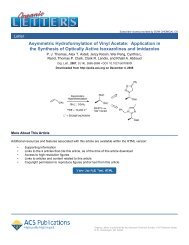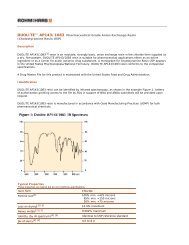Granulation with Dow Cellulosic Polymers II. High Shear Granulation
Granulation with Dow Cellulosic Polymers II. High Shear Granulation
Granulation with Dow Cellulosic Polymers II. High Shear Granulation
Create successful ePaper yourself
Turn your PDF publications into a flip-book with our unique Google optimized e-Paper software.
Model Formulation<br />
2: Vitamin C<br />
Composition and Preparation<br />
In this section of the study, the<br />
following formulations were used:<br />
75% Vitamin C<br />
19.5% Lactose<br />
3.0% Binder<br />
2.0% Disintegrant<br />
0.5% Lubricant<br />
75% Vitamin C<br />
16.5% Lactose<br />
6.0% Binder<br />
2.0% Disintegrant<br />
0.5% Lubricant<br />
Note that these formulations are<br />
identical <strong>with</strong> those used in the earlier<br />
fluid bed study. The formulation at 6%<br />
binder is identical <strong>with</strong> the<br />
acetaminophen model presented in<br />
the previous section except for the<br />
active ingredient; this will facilitate<br />
comparisons on the effects of the<br />
drug on the relative performance of<br />
the various binders. Here, Roche fine<br />
powder was utilized; all of the<br />
remaining components were the<br />
same as described on page 1.<br />
The same binders were evaluated as<br />
described on pages 1 and 2. The<br />
processing of the Vitamin C<br />
formulations was different from that<br />
used in the acetaminophen<br />
formulations. In this case, the active<br />
and the lactose (and the binder in<br />
those experiments where the binder<br />
was not placed in solution) were<br />
placed in the Fuji and mixed for 60<br />
seconds at 200 rpm, chopper speed<br />
high. The granulating liquid was then<br />
added by means of the attached<br />
funnel, and mixing was continued at<br />
200 rpm, chopper speed high until a<br />
proper wet mass was achieved. The<br />
resultant wet mass was discharged<br />
12 <strong>High</strong> <strong>Shear</strong> <strong>Granulation</strong>: Vitamin C Model<br />
and wet milled in a CoMil (model<br />
197S) using a square hole screen<br />
(2A-3750037/63) and an impeller<br />
(2A-1607-086L) at 2665 rpm. This<br />
combination of screen and impeller<br />
worked very well for wet milling for all<br />
binders <strong>with</strong> the exception of PVP<br />
(K90), which had very poor wet<br />
milling properties. After tray drying at<br />
110°F overnight to a moisture content<br />
of < 1%, the granulations were then<br />
dry milled <strong>with</strong> the CoMil using a<br />
round hole grater-type screen<br />
(2A-079G031/23120) and impeller<br />
(2A-1601-173), again at 2665 rpm.<br />
The disintegrant and lubricant were<br />
added to the Vitamin C granulations<br />
in a twin shelled blender and mixed<br />
for 2 minutes. The complete mixtures<br />
then were compressed at 1000,<br />
2000, and 3000 lbs. total<br />
compression force.<br />
Properties of the <strong>Granulation</strong><br />
The apparent and tap densities and<br />
the compressibility indices I of the<br />
Vitamin C granulations were<br />
determined using the procedures<br />
described on page 3, and are given<br />
in Tables 5 and 6. As in Tables 1 and<br />
2, the apparent and tapped densities<br />
are in g/cm 3 .<br />
In this model system using the Fuji<br />
VG-25P, the densities increased as<br />
the binder level was increased from<br />
3% to 6%. For the granulations<br />
produced <strong>with</strong> the METHOCEL and<br />
the HPC products, the increase was<br />
small. However, the PVP binders<br />
(especially the K29-32 grade) showed<br />
a slightly greater increase in density<br />
<strong>with</strong> an increase in binder<br />
concentration. Once again, this<br />
behavior can be understood by<br />
examining the particle size<br />
distributions that are presented in the<br />
figures that follow. Comparing the<br />
results where the binder was<br />
prehydrated <strong>with</strong> those where it was<br />
not shows that in the large majority of<br />
cases, higher densities were obtained<br />
by the "dry" binder addition method;<br />
there was no trend in the I values.<br />
Finally, note that for the comparable<br />
6% binder levels, the compressibility<br />
indices for Vitamin C granulations are<br />
smaller (i.e., indicative of better flow)<br />
than those obtained for the<br />
acetaminophen granulations. It was<br />
observed during tablet compression<br />
that the Vitamin C granulations had<br />
very good flow behavior.<br />
Particle size distributions (PSD),<br />
determined as described on page 4,<br />
are given in Figures 19-27. The<br />
figures show results for both of the<br />
binder addition methods. Figure 19<br />
compares granule sizes <strong>with</strong> 3% and<br />
6% METHOCEL A15P LV. Increasing<br />
the amount of binder gives small<br />
increases in the quantity of material<br />
≤ 60 mesh, but a decrease in the<br />
amount of 40 mesh material. The 6%<br />
binder level (solution) gave the finest<br />
overall PSD. <strong>Granulation</strong> <strong>with</strong><br />
METHOCEL E5P LV (Figure 20)<br />
shows a PSD that is typical of<br />
virtually all of the other binders<br />
tested. Increasing the amount of<br />
binder gave an increase in granules<br />
on 20 mesh, little change at 40 mesh<br />
and < 140 mesh, and small<br />
decreases in all other fractions. The<br />
amount of material 80-140 mesh is<br />
quite small. For the most part, the<br />
binder addition method had relatively<br />
little effect on the PSD at both the 3%<br />
and 6% levels. This general pattern<br />
was true for METHOCEL E15P LV,<br />
METHOCEL F4P LV, METHOCEL<br />
K3P LV (Figure 21), HPC-EF, HPC-<br />
LF (Figure 22), and PVP (K29-32).<br />
In Figure 23, it is seen that the PVP<br />
(K90) granulations of Vitamin C<br />
followed a somewhat different pattern<br />
than the other binders just described.<br />
With this binder, there was less<br />
material on the 40 mesh screen,<br />
somewhat more material on 80 mesh,



